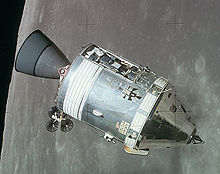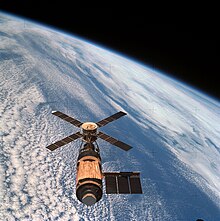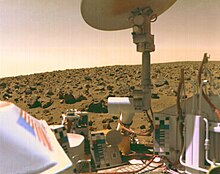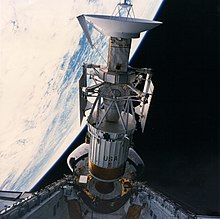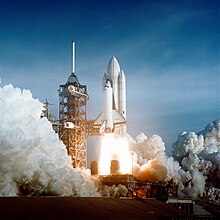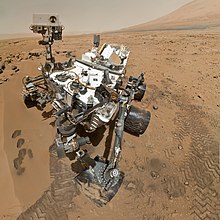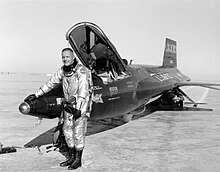History of NASA
This article describes the history of NASA from its founding in 1958 to the present day.
history
1950s and 1960s
Race into space
With the first artificial satellite in space , Sputnik 1 , the Soviet Union drew the attention of the United States to its own space program in 1957 , which was still in its infancy. The United States Congress saw the Soviet success as a threat to national security due to the possibility that the Soviet Union could in the future use its nuclear weapons against United States territory by means of missiles, and demanded immediate and consequent action to protect the US's tarnished reputation as a restore technologically leading nation. US President Dwight D. Eisenhower and his advisors were more in favor of a calm, thoughtful response. After months of deliberation, it was clear that a new agency should be created to be responsible for all non-military space activities. On April 2, 1958, a draft for the establishment of this agency was submitted to Congress. Several hearings were held during parliamentary deliberations until the law was approved .
On July 29, 1958, President Eisenhower signed the National Aeronautics and Space Act , which provided for the creation of the National Aeronautics and Space Administration (NASA). The authority should work with the greatest possible scientific openness ( "provide for the widest practicable and appropriate dissemination of information concerning its activities and the results thereof" ). On August 8, it was not Hugh Latimer Dryden , the director of the NACA, as expected , but Thomas Keith Glennan , who was considered an advocate of manned space travel. Glennan named Dryden his deputy. The new authority began its work on October 1, 1958. At that time, it consisted of four laboratories and around 8,000 employees who came from the 43-year-old National Advisory Committee for Aeronautics (NACA) and the teams that joined NASA from the Army.
NASA's first projects dealt with manned space travel and led to the space race . The Mercury program of 1958 was the first step: one investigated whether and under what conditions a person could survive in space. But here, too, the Soviet Union beat the United States: On April 12, 1961, the Soviet cosmonaut Yuri Gagarin completed his spectacular first space flight with Vostok 1, orbiting the earth once in 108 minutes.
On May 5, 1961 the time had come for NASA: Alan Shepard was the first American in space when he reached space in an arc-shaped flight for 15 minutes with Mercury 3 . The first American to orbit the earth was John Glenn at Mercury 6 on a five-hour flight on February 20, 1962.
After the first fundamental experience in manned space flight had been gained with the Mercury flights, NASA launched the Gemini program . In this project experiments should be carried out and problems related to a moon landing mission should be worked on. The first manned flight of a Gemini rocket was made on March 23, 1965 by Virgil Grissom and John Young . Nine more missions followed, in which the feasibility of longer stays in space and the meeting and docking of two spaceships was demonstrated. These flights also collected medical data on the effects of weightlessness on the human body.
Apollo program
After the success of the Mercury and Gemini programs, the Apollo program was launched to conduct further experiments in space and, ideally, even to bring people close to the moon . The Apollo program underwent a massive change in its conception with the announcement of its new President, John F. Kennedy . On May 25, 1961, he said the United States should resolve "before the end of this decade to land a person (or: a man) on the moon and bring him safely back to earth." From now on, the aim of the Apollo program was to bring astronauts to the moon.
After eight years of preparatory missions, which included the first major disaster in NASA history - all three crew members of the Apollo 1 mission perished when a fire broke out during a ground test in the spacecraft - the Apollo program finally came to an end Objective: On July 20, 1969, Neil Armstrong and Buzz Aldrin, the first humans to land on the moon, and returned safely to earth on July 24. When Armstrong stepped out of the Apollo 11 lunar module, he radioed the well-known sentence to Earth: “That's one small step for [a] man, one giant leap for mankind.” (“That's a small step for a person, but a huge one Leap for humanity. "). After Armstrong and Aldrin, ten more people landed on the moon by the end of the Apollo program in December 1972.
By landing on the moon, NASA had won the most sensational stage in the space race. This actually represented the desired success, but now there was no goal that was worth working towards. In addition, the public interest, which was absolutely necessary in order to secure large budgets through Congress, waned. With Lyndon Johnson , NASA then also lost its most important political supporter. Wernher von Braun worked for him as a lobbyist in Washington.
There were plans for ambitious follow-up projects, such as setting up a space station , a lunar base or starting a manned mission to Mars by 1990. After the end of the procurement of Saturn and Apollo rockets, there was hardly any support. After it almost came to a catastrophe with Apollo 13 , in which the explosion of an oxygen tank would have killed almost all three astronauts, NASA received more attention from the population again. But although Apollo missions were planned up to Apollo 20 , Apollo 17 was the last mission under the name "Apollo". Reasons for the end of the missions were budget cuts, partly due to the Vietnam War , and the hope of being able to build a reusable spaceship in the near future.
Planetary missions from 1960 to 1970
From today's perspective, the first space probes with which NASA explored the planets of the solar system were simply built, probing missions that were produced in small series and, with calculated losses, were usually designed as a double mission. It was not until the 1970s that the development of more demanding missions began, with probes individually adapted to the tasks.
The first NASA planetary probe was Mariner 1 , which launched for Venus in July 1962, but failed. The sister probe Mariner 2 took off a month later and flew successfully past Venus for the first time. The Mars mission Mariner 3 , launched two years later, failed, but the sister probe Mariner 4, launched in November 1964, managed to fly by Mars for the first time. In June 1967 the Venus flyby probe Mariner 5 followed , in February and March 1969 the Mars flyby probe Mariner 6 and 7 . All three missions were successful.
Unmanned lunar exploration
In preparation for the manned moon landing, NASA carried out an intensive exploration of the earth's satellite with robotic probes in the 1960s. After the flyby probe Pioneer 4, still operated by the US military, was the first US spacecraft to pass the moon in 1959 - but after Lunik 1 - the other Pioneer lunar probes all failed in 1959/60. Of the nine probes of the Ranger program , which were launched to the moon between 1961 and 1965, only the last three successfully transmitted images of the lunar surface (impact capsules). The two successor programs worked better: five Surveyor probes landed softly on the moon between May 1966 and January 1968, two probes failed (here, too, the USSR was faster: Luna 9 landed softly on the moon for the first time in February 1966). The five lunar orbiters successfully mapped the lunar surface between August 1966 and January 1968.
1970s and 1980s
After the moon flights with Apollo 17 ended prematurely in late 1972, only two manned projects were carried out in the 1970s: from 1973 to 1974 three flights to the Skylab space station and in 1975 the Apollo Soyuz project .
To reduce the cost of transport to space, NASA began developing a reusable space glider in the late 1960s. However, this task turned out to be more complex, tedious and expensive than originally assumed. When NASA's total budget fell sharply, the construction of the space shuttle withdrew funds from unmanned missions, especially in the late 1970s and early 1980s.
Planetary exploration
The unmanned exploration of the solar system also included the “space race”. The Soviet Union was successful in 1970 with the Venus probe Venera 7 , the first landing on a foreign planet. However, since there could be no life there under the environmental conditions of Venus and a manned exploration would not be possible, NASA concentrated on the exploration of Mars. While the USSR carried out an extensive Venus program, the US only sent the Pioneer-Venus double mission there in that decade . Plans for this project had existed since 1965. After delays and budget cuts, the mission was approved in 1975, and in 1978 the landing probes (Multiprobe) and the orbiter, whose primary mission ran until 1980 and which was still active until 1992, started.
In the mid-1960s, NASA was working on an ambitious Mars mission, the Voyager Project, but it turned out to be too big and expensive. In 1968, Mariner 8 and 9 were approved as replacements and launched to Mars in 1971 (Mariner 8 had a false start). In 1972, Mariner 9 entered orbit around Mars, making it the first orbiter around another planet. In order to be able to clarify the question of life on Mars , one had to examine the planet's surface directly with a landing probe.
As a follow-up to the Voyager project, which was discontinued in 1967, Viking was decided in late 1968 . This mission consisted of two landers and two orbiters and was the first major planetary research project. The original launch was scheduled for 1973, but was postponed to 1975 due to the shrinking NASA budget and the simultaneous rise in development costs. The lander successfully reached the surface of Mars in 1976 and could be contacted until 1980 and 1982 respectively. The orbiters also worked well beyond the primary mission until 1978 and 1980, respectively. Viking was one of the most complex and expensive NASA space probes.
As part of a long-term Mars exploration program, an orbiter to study the climate and a mobile rover should follow. For financial and political reasons, these plans could only be realized in the 1990s with the Mars Observer and in the 2000s with the Mars Exploration Rovers Spirit and Opportunity .
The only inner planet that had not yet been explored was Mercury . That is why Mariner 10 was decided in early 1970 . The flyby probe started in 1973 and successfully explored Mercury in three encounters by the end of the mission in 1975. Mariner 10 was the first planetary probe to use swing-by technology.
In the late 1960s, NASA developed plans to also explore the outer planets with space probes. A very favorable planetary constellation at the end of the 1970s represented a special opportunity for this, which made it possible to visit all four planets with a probe. From 1969 onwards, mission concepts for the Grand Tour Suite or the Outer Planets Grand Tour Project and the Thermoelectric Outer Planets Spacecraft (TOPS) were drawn up, which still provided for four to five probes. Since these plans were too big and expensive, they were canceled in early 1970 and the Voyager program was approved as a cheaper alternative in 1972 (no connection with the Mars program of the same name). Until then, it was unclear whether it would be possible to safely cross the asteroid belt between Mars and Jupiter with a spacecraft and how much the radiation at Jupiter would damage a space probe. That is why Pioneer 10 and Pioneer 11 have been developed as exploratory missions since 1969 . Pioneer 10 was launched in 1972 and was the first probe to fly past Jupiter in late 1973. A year after the sister probe, Pioneer 11 was launched in 1973, reaching Jupiter in late 1974 and Saturn for the first time in 1979. This paved the way for the Voyager probes: In 1977 Voyager 1 and Voyager 2 began their long journey. Voyager 1 reached Jupiter in 1979 and Saturn in 1980 and carried out an extensive research program. Voyager 2 reached the two planets in 1979 and 1981, was able to carry out the Grand Tour in the extended mission phase and met Uranus in 1986 and Neptune in 1989. The Voyager probes, which are still working today, are among NASA's most successful projects.
At the end of the 1970s, NASA's situation had changed dramatically. After the Apollo program came to an end, many employees had to leave the organization, the available financial resources were considerably lower than in the late 1960s, the development of the space shuttle consumed a large part of the budget, and political support waned. Few new missions were approved under this framework.
One project was the Jupiter Orbiter / Probe (JOP) , which was later renamed Galileo . The first ideas for this had been around since 1974, the first funds for the development were made available in 1977, the launch of the space probe should then take place originally in 1982 with the space shuttle, the end of the mission was planned for 1988. The delays in the construction of the space shuttle, however, led to a postponement of the start date to 1986. In 1982 the Reagan administration even wanted to cancel the 90% completed probe completely, only massive public pressure saved the mission. In mid-1985 Galileo was ready to take off, but in January 1986 the space shuttle Challenger had an accident , whereupon NASA stopped all launches until the cause of the accident was clarified. Galileo was dismantled and revised in 1987 and was finally able to start in 1989. In 1995 the probe reached the Jupiter system, which it explored until 2003.
The second new mission in the late 1970s and early 1980s was VOIR (Venus Orbit Imaging Radar) . This probe was primarily intended to use imaging radar (SAR) to map the surface of Venus. Further budget cuts in 1982 led to the cancellation of this project. In addition, another main scientific mission was abandoned: the solar probe International Solar Polar Mission . As a replacement, some US experiments flew on the European sister probe Ulysses . As early as 1979, the American partner probe of the European Giotto mission for the international exploration of the Halley comet was canceled.
In 1983, a NASA internal committee recommended a new strategy for exploring the solar system with spacecraft at low to moderate costs. Four important core missions for future planetary exploration have been proposed: a scaled-down VOIR mission, a Mars orbiter, the Comet Rendezvous Asteroid Flyby (CRAF) probe and a Saturn Orbiter / Titan Probe (SOTP) .
After the planned Venus mission had been reduced to a single scientific instrument and was to be built from spare or replacement parts from earlier probes, the costs were now low enough for a new start of the project in 1984 as the Venus Radar Mapper , the later Magellan probe. The original launch was scheduled for 1988, but the Challenger disaster postponed it to 1989. From 1990 to 1992 Magellan successfully mapped almost the entire surface of Venus in high resolution, and in 1994 the probe burned up in the Venusian atmosphere.
Ronald Reagan announced the beginning of the Strategic Defense Initiative (SDI) in 1983 and the construction of the Freedom space station (a nucleus of the later ISS ) in 1984 as the next major military or manned space projects. A clear improvement in the financial situation of scientific unmanned space travel was therefore not to be expected in the next few years.
In 1984 the development of the Mars Geoscience / Climatology Orbiter (MGCO) , the later Mars Observer , which was to continue the research of Viking and Mariner 9, began. The start planned for 1990 had to be postponed to 1992 after the Challenger accident. Unfortunately, contact with the probe was lost shortly before it swung into a Mars orbit. The relatively expensive Mars Observer is considered the biggest failure of a robotic mission in NASA history and was the first probe to fail since 1967. It could be largely replaced by the missions of Mars Global Surveyor and 2001 Mars Odyssey in the late 1990s / early 2000s. The third replacement Mars Climate Orbiter also failed.
For the 1990 budget year, funds were approved for the next two projects: Cassini-Huygens (the former SOTP) and the comet probe CRAF. Again with a tight budget and rising costs for the space station, two instruments were canceled by CRAF in 1991 and the entire probe in 1993. Cassini, on the other hand, was built and launched in 1997. The probe has been working successfully in the Saturn system since 2004.
Another important unmanned mission of this period is the Hubble Space Telescope , launched in 1990 , which has been developed and built since 1977 and was originally scheduled to start in 1986.
Space shuttle era
After the successful moon landing, the contemporary NASA planners saw the commercialization of space travel as the next logical step. To do this, however, the transport costs into space had to be significantly reduced. The solution to this problem was based on reusable systems. Since the late 1960s, there have been various studies that dealt with the concept of a space glider. Development of the space shuttle began in 1972 with a planned first start in early 1978. The project quickly became expensive and took more time. On April 12, 1981, the Columbia space shuttle successfully launched its first shuttle mission. 31 more flights of the four space shuttles followed in the 1980s. The Challenger launched on April 4, 1983 , the Discovery was first used on August 30, 1984 and the Atlantis on October 3, 1985 .
A serious accident occurred on January 28, 1986 when the space shuttle Challenger exploded during takeoff ( Challenger accident ). Up until that day it was one of the worst accidents in NASA history. In the 1990s, the US began cooperation with Russia. The shuttle made nine flights to the MIR space station .
Another serious accident with a space shuttle occurred when on February 1, 2003 the space shuttle Columbia broke apart and burned up when it reentered the earth's atmosphere, which, as in the Challenger disaster, led to a long flight break for the remaining space shuttle fleet. The seven-man crew was killed in both accidents. In 2011 the shuttle flights ended and the three remaining space shuttles were decommissioned and ended up at museums in the USA.
1990s: "Faster - Better - Cheaper"
In the early 1990s, NASA experienced two setbacks in planetary exploration. On the one hand the expensive Mars Observer mission failed completely, on the other hand the main antenna of the Jupiter probe Galileo failed, so that only a small part of the actual amount of data could be sent to earth. Both projects cost approximately $ 1 billion each. At the same time, the simple, inexpensive Magellan probe, which used many components from older missions, was successful in radar mapping Venus. In addition, the experience of the last decade has shown that political disinterest in space research and the alignment of political priorities to military projects have repeatedly endangered expensive and long-term missions to explore the solar system. If the overall budget is generally tight, money should be saved. The construction costs of the planetary missions had to fall. Since 1989 there has been a discussion in NASA about cheaper, smaller planetary probes. In 1992, NASA boss Daniel Goldin presented his concept of “faster, better, cheaper” , which was to be implemented primarily in the new Discovery program . Now there should be more spacecraft launches, whose development time was much shorter. These specialized probes had a limited payload for scientific experiments and were also lighter overall, which reduced launch costs. Instruments should be reused whenever possible. The missions were regularly selected as part of a competition. A mandatory upper limit for the mission costs in the Discovery program has been introduced. In 1993 the first two projects were decided: the asteroid probe NEAR , which was launched in February 1996, and the technology demonstrator Mars Pathfinder (launched in December 1996). The two other Discovery missions of the 1990s were the lunar probe Lunar Prospector (selection 1994, launch 1998) and the comet probe Stardust (launch 1999).
However, the new concept should also be applied to other programs. A long-term Mars program had already been considered during the development of Mars Observer. An early concept envisaged a network of several small countries ( Mars Environmental Survey - MESUR ). At the beginning of the 1990s, after the failure of the Mars Observer mission, a long-term program for the exploration of Mars was decided with the Mars Surveyor Program. For the next 10 years, relatively inexpensive orbiters and landers should launch to Mars every 26 months. The program started in late 1994, and the first probe was Mars Global Surveyor , which reused much of the Mars Observer's instruments. The mission started at the end of 1996 and worked successfully until November 2006. The Mars Climate Orbiter that followed in 1998, as well as the Mars Polar Lander launched in 1999, were both lost. After these missions failed, the “faster, better, cheaper” approach came under fire . The next orbiter 2001 Mars Odyssey (launched 2001), which like the Mars Climate Orbiter still carried some of the instruments of the Mars observer, was successful, but the subsequent missions were better financed.
Manned spaceflight in the 1990s
At the end of 1989 the then President George HW Bush announced with the Space Exploration Initiative the permanent return of the USA to the moon and manned flights to Mars. Since the cost of this was estimated at several hundred billion US dollars, these plans were soon abandoned. However, this project was revitalized in 2004 by George W. Bush's Vision for Space Exploration .
In May 1992 the space shuttle Endeavor had its maiden flight and replaced the failed Challenger. Until the Columbia accident, four space shuttles were in use again. A total of 64 flights were carried out with the space shuttles from 1990 to 1999 . In the Shuttle Mir program, Russia and the USA cooperated again in manned space travel for the first time since the Apollo Soyuz project. From 1994 to 1998 there were 11 missions to the space station, seven space travelers completed long-term stays on the Mir. This cooperation served as preparation for the International Space Station (ISS), the construction of which began in November 1998 with the launch of the Russian cargo and propulsion module Zarya . Shortly afterwards, the STS-88 space shuttle mission brought the first US component into space , the Unity connection node . The construction of the space station was agreed between the USA and Russia in 1993, and other countries joined the contract.
Earth observation

In addition to the planned Freedom space station , NASA was looking for further long-term main projects for the future in the late 1980s. In view of the criticism of the authority because of the Challenger accident, the positive public perception of NASA through its quick confirmation of the ozone hole discovered in 1985 led to a favorable political starting point for anchoring earth observation as a focus in the NASA program. In 1987 the " mission to planet earth " was proposed and officially confirmed in 1990, the centerpiece of which was the Earth Observing System (EOS) . The plans originally envisaged the launch of two large and complex platforms. Budget reasons led to a new planning of the system in the early 1990s, so that three medium-sized satellites were developed as core elements of the EOS: Terra (land observation) was launched in 1999, Aqua ( ocean exploration) in 2002 and Aura (atmospheric research) in 2004 .
However, the first satellite within the "mission to planet earth" program was the Upper Atmosphere Research Satellite, launched in 1991 . This novel environmental satellite, for which there had been plans since 1978 and whose construction was approved in 1984, continued NASA's successful research into the destruction of the ozone layer and provided politicians with important data for verifying compliance with the Montreal Protocol . Other important EOS predecessor missions were TOPEX / Poseidon (Start 1992) and Tropical Rainfall Measuring Mission (Start 1997), the positive results of which demonstrate the practical use of environmental satellites e.g. B. showed in the severe weather forecast.
However, research on global warming, which since the early 1990s has gained more weight than ozone research, was politically conflictual. The latter began in the early 1970s to better address concerns of the environmental movement about possible pollution of the stratosphere by the space shuttle under development. In 1975 and 1977 laws were passed by Congress that gave NASA the right to conduct environmental research.
1972 with the start of the "Earth Resources Technology Satellite" , later Landsat 1, a new class of earth-oriented satellites was introduced. After the Viking probe explored almost all of Mars in search of a suitable landing site in 1976, this led to the idea of using investigation methods that had previously only been used in planetary research in Earth exploration. This was achieved with the marine exploration satellite Seasat, which was launched in 1978 .
New theories in the early 1980s of the earth as a whole system, which were also influenced by the comparative planetary research that emerged from the Mars and Venus flybys of the Mariner probes in the mid-1960s, made earth exploration satellites indispensable for the development of global models and ultimately led to organized Earth Science program .
More scientific missions
NASA launched numerous research satellites and probes to explore near and far space, including the telescopes OAO (1972–1981), HEAO (1977–1979), IRAS (1983), FUSE (1999–2007) and STEREO (since 2006) .
From 1989 the research of cosmic microwave background radiation served the missions COBE (1989–1993) and WMAP (since 2001).
As part of the Great Observatory Program , NASA started four space-based telescopes in 1990 to explore the distant universe in all important wave spectra. Hubble was started in 1990 for the range of visible light as well as ultraviolet and infrared radiation . The Compton Gamma Ray Observatory for Gamma Astronomy followed in 1991, the Chandra X-ray telescope in 1999 and the Spitzer Space Telescope , an infrared telescope , finally in 2003. These will be followed in the medium term by even more powerful successors such as the Gamma-ray Large Area Space Telescope (2008) and the James Webb Space Telescope (around 2021) replaced.
21st century
Unmanned space travel
Space probes to the celestial bodies of the solar system
In the late 1990s, Pluto was the only planet that had not yet been explored by a space probe. In order to be able to study Pluto's atmosphere, which threatens to freeze out for the next two hundred years due to its orbital properties, a space probe should be launched no later than 2004. Another body of the outer solar system with priority in research was Jupiter's moon Europa, under whose ice crust there could be an ocean of water, according to data from the Galileo mission. That is why from 1996 in the Fire & Ice project and from 1998 in the Outer Planets / Solar Probe Program, developments for three space probes began: Pluto Express and Pluto-Kuiper-Express (also PKE) , Europa Orbiter and Solar Probe , a mission for solar research. For all three projects it was planned to develop a common space probe body (Spacebus) that was to be extremely light, highly radiation-resistant and energy-saving. However, the development was more complex than originally expected and therefore required further development time and additional financial resources. The launch of the Europa orbiter was initially postponed from 2004 to 2006. In September 2000 NASA decided to stop work on the Pluto-Kuiper-Express. At the beginning of 2002 the European mission was also discontinued.
However, strong public protests sparked a revival of the Pluto mission. In November 2001 the concept for New Horizons was selected, so that the probe could be built from 2003 and started in January 2006. New Horizons became the first mission of the New Frontiers program for medium-sized space probes, modeled on the Discovery program . The Jupiter probe Juno was launched in 2011 as the second probe in this program . In 2003, work began on the Jupiter Icy Moons Orbiter (JIMO) to research the Jupiter system . This rather ambitiously dimensioned probe as part of the Prometheus project was supposed to show that it would be feasible to supply a space mission with energy from a nuclear reactor. The project was discontinued in early 2005.
All other space probes - with the exception of the Mars, lunar and solar probes - are part of the Discovery program. The Mercury probe MESSENGER was selected in 1999 and started in 2004. It reached the innermost planet in 2008 and is to explore it in detail by 2012. Dawn was launched in 2007 to explore the asteroids Vesta and Ceres . The Stardust , CONTOUR and Deep Impact probes have been and are used to research comets, but CONTOUR was destroyed when it was launched in 2002. The partially successful Genesis probe examined the solar wind. At the end of 2007, the moon mission GRAIL was selected, which will measure the moon's gravitational field from 2011 onwards. Other lunar probes are the Lunar Reconnaissance Orbiter and LCROSS, which are to investigate the moon as part of the Vision for Space Exploration, especially with regard to later manned expeditions.
After the failure of the Mars program in the late 1990s, more money was invested in the next 2001 Mars Odyssey probe , but at the expense of the Mars Surveyor 2001 Lander. This almost completed lander was launched in a revised version as Phoenix as part of the Mars Scout Program 2007. For the following 2003 launch window, the concept of the Athena rover competed with an orbiter in 1999 . The rover concept was chosen so that the Mars Exploration Rovers were built from May 2000 and launched in 2003. Since January 2004 Spirit and Opportunity have been successfully exploring the surface of Mars. The orbiter was sent to Mars as the Mars Reconnaissance Orbiter in the next launch window in 2005 . Both the rovers and the orbiter reflect the new Mars program, which turned from the smaller, cheaper missions of the 1990s to medium-sized probes.
Mars was again chosen as the research destination for the only flagship mission of the decade. In 2009 it was planned to send a significantly larger and more powerful mobile laboratory with a nuclear power supply to Mars than the Mars Exploration Rover . The complexity of this task led to delays and required additional funding by the start of the shifted Curiosity baptized Mars Science Laboratory on the 2011th
For the flagship mission of the decade 2013–22, a scientific advisory board of planetary researchers (the Committee on the Planetary Science Decadal Survey ) developed this ranking list with suggestions: Mars Astrobiology Explorer-Cacher , Jupiter Europa Orbiter , Uranus Orbiter and Probe , Enceladus Orbiter or Venus Climate Mission . Ultimately, because of the difficult budget situation in the USA, no funds were approved for such a multi-billion dollar mission. In addition, the Mars program had to accept cuts from 2013. The smaller MAVEN probe was launched in 2013 as part of the Mars Scout program . When selecting the next project in the Discovery program, NASA also decided on a mission to Mars: The InSight probe is based on the Phoenix Land and started in May 2018. OSIRIS-REx started in 2016 as the third mission of the New Frontiers program an asteroid and is supposed to bring rock samples back to earth from there . As a replacement for the canceled Mars Astrobiology Explorer , a further development of the Curiosity rover is to start in 2020 [out of date] with the Mars 2020 mission , with a collection container for rock samples in view of a planned Mars sample return mission after 2025.
In addition to Mars, the exploration of the moon is a focus in NASA's planetary program. In 2013 the LADEE probe was sent to the earth's satellite. Numerous other lunar probes are planned for the period from 2021.
For the study of Jupiter's moon Europa (moon) is the European Clipper mission in work, and in 2026 , the lander will Dragonfly on Saturn's moon Titan launch.
Earth observation
NASA continued to build the EOS during this decade, so that in 2008 a fleet of 15 Earth observation satellites was available to study the atmosphere, land areas, oceans, ice areas and solar radiation.
After the Columbia accident in February 2003, there was a thorough review of the priorities and objectives of NASA's entire space program. On January 14, 2004, President GW Bush announced the “Vision for Space Exploration”, a long-term program that was to resume the exploration of the moon through manned flights, in order to finally land astronauts on Mars. No additional funds were earmarked for this project; instead, the necessary funds were to be raised through internal redeployment that was at the expense of Earth observation and the entire scientific program. As a result, ongoing developments were delayed and plans for follow-up missions had to be partially abandoned.
Exploration of the sun and astrophysical missions
The Helios 1 and Helios 2 probes started in the 1970s in cooperation with Germany with the aim of researching our sun. The two probes fly in similar but staggered orbits. So you can take 3D images.
Manned space travel
- Presence on the International Space Station
- Operation of the space shuttle until 2011
- Launch and discontinuation of the Constellation program
Aeronautical research
When it was founded, NASA took over the employees, facilities and ongoing research programs (e.g. the X-15 program) of NACA , an aeronautical research facility that has existed since 1915. Since the late 1950s, NASA has been researching a wide variety of aviation issues in collaboration with industry and the military.
For example, new wing shapes were investigated, the safety of aircraft in storms increased (aquaplaning during take-off and landing, improved protection of avionics and aircraft electronics against lightning strikes) and air traffic management systems developed. In the 1970s, NASA was involved in the introduction of electronic screens in the cockpits, which replaced the mechanical displays; digital fly-by-wire systems replaced hydraulic flight control systems. NASA researched the reduction of aircraft noise and the use of improved composite materials in aircraft construction. A variety of technologies for supersonic flight were tested with the experimental X-15 aircraft. In the 2000s, NASA conducted experiments with ramjet and scramjet engines ( X-43A ).
Annual budgets
| year | budget | Share of total US budget | Inflation-adjusted budget (compared to 2018) |
|---|---|---|---|
| 1958 | 0.09 billion . U.S. dollar | 0.1% | |
| 1959 | $ 0.1 billion | 0.2% | |
| 1960 | $ 0.4 billion | 0.5% | |
| 1961 | $ 0.7 billion | 0.9% | |
| 1962 | $ 1.3 billion | 1.2% | |
| 1963 | $ 2.6 billion | 2.3% | $ 22 billion in 2020 |
| 1964 | $ 4.2 billion | 3.5% | |
| 1965 | $ 5.0 billion | 4.3% | $ 40 billion |
| 1966 | $ 5.9 billion | 4.4% | |
| 1967 | $ 5.4 billion | 3.5% | |
| 1968 | $ 4.7 billion | 2.7% | |
| 1969 | $ 4.3 billion | 2.3% | |
| 1970 | $ 3.8 billion | 1.9% | |
| 1971 | $ 3.4 billion | 1.6% | |
| 1972 | $ 3.4 billion | 1.5% | |
| 1973 | $ 3.3 billion | 1.4% | $ 19 billion |
| 1974 | $ 3.3 billion | 1.2% | |
| 1975 | $ 3.3 billion | 1.0% | |
| 1976 | $ 3.7 billion | 1.0% | |
| 1977 | $ 4.0 billion | 1.0% | |
| 1978 | $ 4.2 billion | 0.9% | |
| 1979 | $ 4.4 billion | 0.9% | |
| 1980 | $ 5.0 billion | 0.8% | $ 15 billion |
| 1981 | $ 5.5 billion | 0.8% | |
| 1982 | $ 6.2 billion | 0.8% | |
| 1983 | $ 6.9 billion | 0.9% | |
| 1984 | $ 7.0 billion | 0.8% | |
| 1985 | $ 7.3 billion | 0.8% | |
| 1986 | $ 7.4 billion | 0.8% | |
| 1987 | $ 7.6 billion | 0.8% | |
| 1988 | $ 9.1 billion | 0.9% | |
| 1989 | $ 11.0 billion | 1.0% | |
| 1990 | $ 12.5 billion | 1.0% | $ 24.1 billion |
| 1991 | $ 13.9 billion | 1.1% | |
| 1992 | $ 14.0 billion | 1.0% | |
| 1993 | $ 14.3 billion | 1.0% | |
| 1994 | $ 13.7 billion | 0.9% | |
| 1995 | $ 13.4 billion | 0.9% | |
| 1996 | $ 13.9 billion | 0.9% | |
| 1997 | $ 14.4 billion | 0.9% | |
| 1998 | $ 14.2 billion | 0.9% | |
| 1999 | $ 13.6 billion | 0.8% | |
| 2000 | $ 14.4 billion | 0.8% | $ 21.1 billion |
| 2001 | $ 14.1 billion | 0.8% | |
| 2002 | $ 14.4 billion | 0.7% | |
| 2003 | $ 14.6 billion | 0.7% | |
| 2004 | $ 15.2 billion | 0.7% | |
| 2005 | $ 15.6 billion | 0.6% | |
| 2006 | $ 15.1 billion | 0.6% | |
| 2007 | $ 15.9 billion | 0.6% | |
| 2008 | $ 17.8 billion | 0.6% | |
| 2009 | $ 19.2 billion | 0.5% | |
| 2010 | $ 18.7 billion | 0.5% | |
| 2011 | $ 18.5 billion | 0.5% | |
| 2012 | $ 17.8 billion | 0.5% | |
| 2013 | $ 16.9 billion | 0.5% | |
| 2014 * | $ 17.7 billion | 0.5% | |
| 2015 ** | $ 18.0 billion | 0.5% | |
| (*) decided | |||
| (**) estimated | |||
literature
- Roger D. Launius, Howard E. McCurdy (Eds.): NASA Spaceflight: A History of Innovation. Peter Lang, Cham 2017, ISBN 978-3-319-60112-0 .
Web links
Individual evidence
- ↑ Richard Pipes : Why the Soviet Union Thinks It Could Fight & Win a Nuclear War in Commentary magazine in July 1977.
- ↑ An Administrative History of NASA 1958–1963 from 1966.
- ↑ Legislative Origins of the National Aeronautics and Space Act of 1958 of April 3, 1992 on history.nasa
- ^ The National Aeronautics and Space Act , NASA Office of the General Counsel, accessed October 16, 2009.
- ↑ Open Government at NASA in the founding act 1958.
- ^ Brian Harvey: Discovering the Cosmos with Small Spacecraft: The American Explorer Program on page 31
- ^ David M. Harland: Exploring the Moon: The Apollo Expeditions. 2nd Edition. Springer, Berlin 2008, ISBN 978-0-387-74638-8 , p. Xx.
- ^ Hertzfeld, Henry R. / Williamson Ray A .: The Social and Economic Impact of Earth Observing Satellites. In: Dick, Steven J. / Launius, Roger D .: Societal Impact of Spaceflight. (PDF; 4.8 MB) Washington, DC 2007, pp. 237–263.
- ^ Conway, Erik M: Satellites and Security: Space in Service to Humanity. In: Dick, Steven J. / Launius, Roger D .: Societal Impact of Spaceflight. (PDF; 4.4 MB) Washington, DC 2007, pp. 278–286.
- ↑ Lambright, W. Henry: NASA and the Environment: Science in a Political Context. In: Dick, Steven J. / Launius, Roger D .: Societal Impact of Spaceflight. (PDF; 4.4 MB) Washington, DC 2007, pp. 313–330.
- ^ Handberg, Roger: Dual-Use as Unintended Policy Driver: The American Bubble. In: Dick, Steven J. / Launius, Roger D .: Societal Impact of Spaceflight. (PDF; 4.4 MB) Washington, DC 2007, pp. 363–364.
- ↑ W. Henry Lambright: NASA and the Environment: The Case of Ozone Depletion. (PDF; 2.3 MB) Washington, DC 2005, pp. 11–29.
- ↑ NASA: NASA Completes Webb Telescope Review, Commits to Launch in Early 2021. June 29, 2018, accessed on December 13, 2018 .
- ↑ Committee on the Planetary Science Decadal Survey, Space Studies Board, Division on Engineering and Physical Sciences, National Research Council (Ed.): Vision and Voyages for Planetary Science in the Decade 2013-2022 . National Academies, January 13, 2012 ( limited preview in Google Book Search).
- ^ Goldstein, Edward S .: NASA's Earth Science Program. The Space Agency's Mission to Our Home Planet. In: Dick, Steven J. (Ed.): NASA's First 50 Years. Historical Perspectives. (PDF; 9.5 MB) Washington, DC 2010, pp. 503–542.
- ^ Springer, Anthony M .: NASA Aeronautics. A Half Century Of Accomplishments. In: Dick, Steven J. (Ed.): NASA's First 50 Years. Historical Perspectives. (PDF; 9.5 MB) Washington, DC 2010, p. 183-204.
- ↑ The Guardian: Nasa budget: US spending on space travel since 1958


